Roles, Theories, and Functions of Leaders and Managers at Softwire
VerifiedAdded on 2020/10/04
|19
|4677
|27
Report
AI Summary
This report provides an in-depth analysis of leadership and management within Softwire, a UK-based software development company. It begins by defining and comparing the roles and characteristics of leaders and managers, highlighting their distinct responsibilities and approaches. The report then explores various leadership theories, including trait theory, situational theory, transactional theory, path-goal theory, and transformational theory, explaining their relevance to Softwire's operations. Furthermore, it examines the functions of managers in different situational contexts, such as decision-making, conflict resolution, and risk management. The report also delves into the application of different leadership models and approaches, such as trait, contingency, transactional, transformational, and system theories, to understand how leaders handle various challenges and drive organizational success. This comprehensive analysis provides valuable insights into effective leadership and management practices in the software development industry.
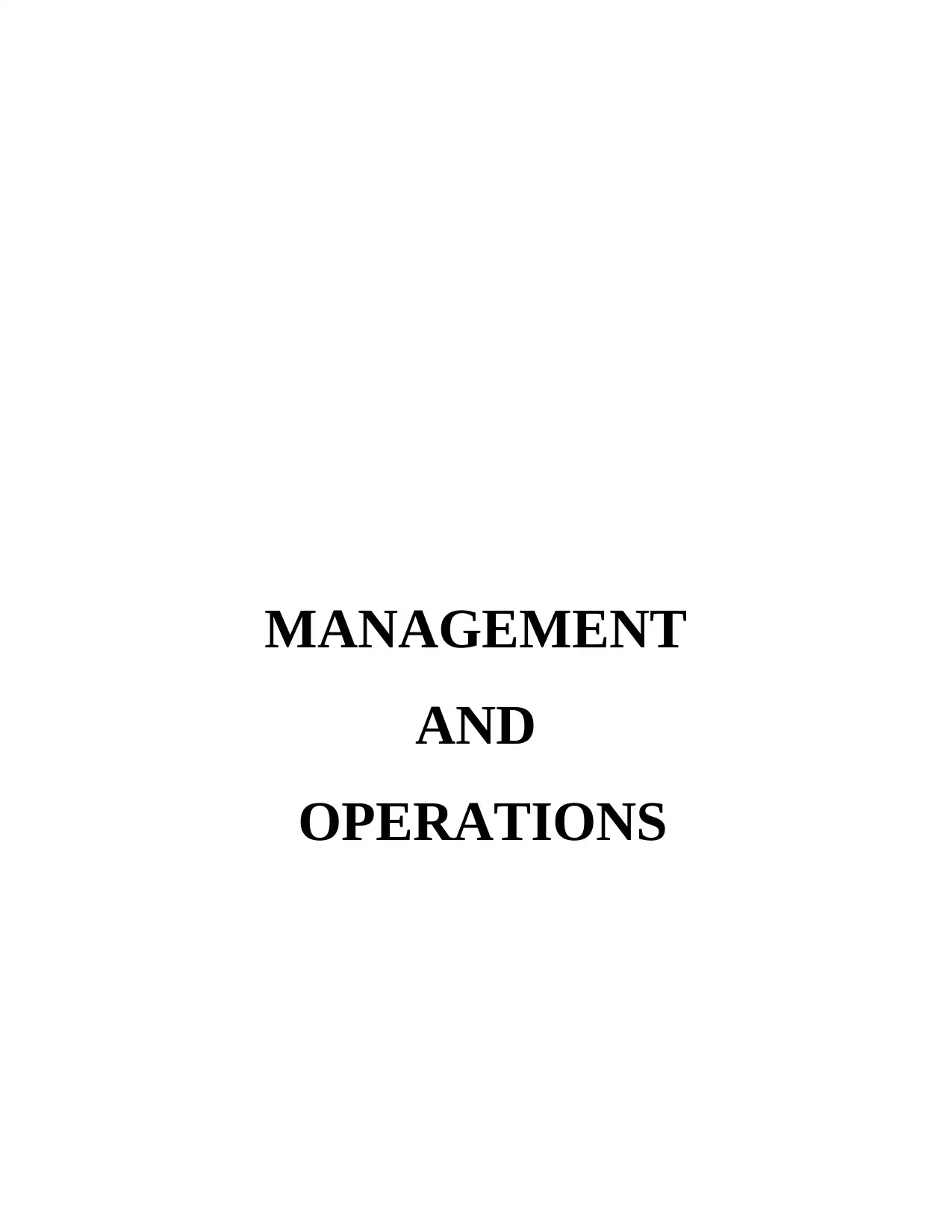
MANAGEMENT
AND
OPERATIONS
AND
OPERATIONS
Paraphrase This Document
Need a fresh take? Get an instant paraphrase of this document with our AI Paraphraser

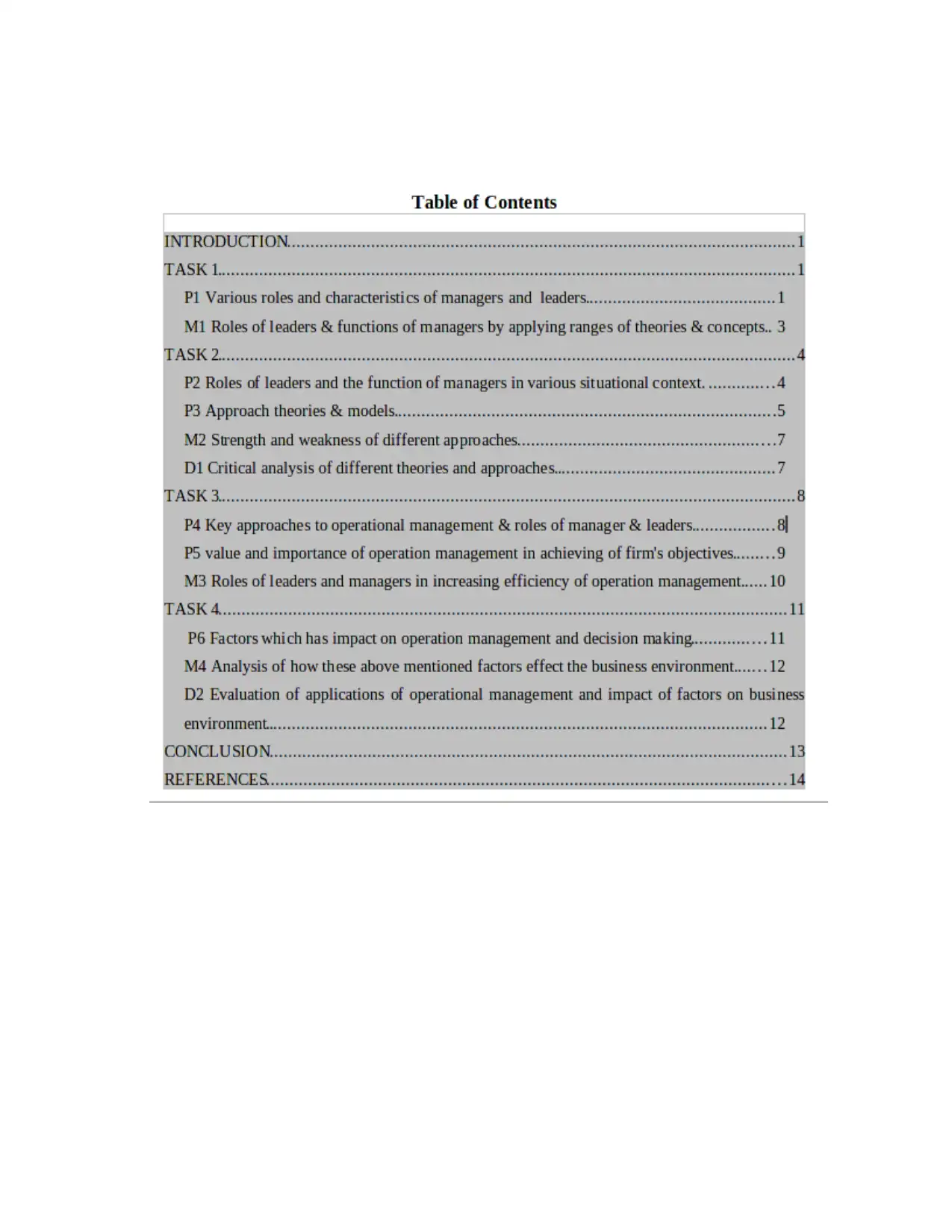
⊘ This is a preview!⊘
Do you want full access?
Subscribe today to unlock all pages.

Trusted by 1+ million students worldwide

Paraphrase This Document
Need a fresh take? Get an instant paraphrase of this document with our AI Paraphraser
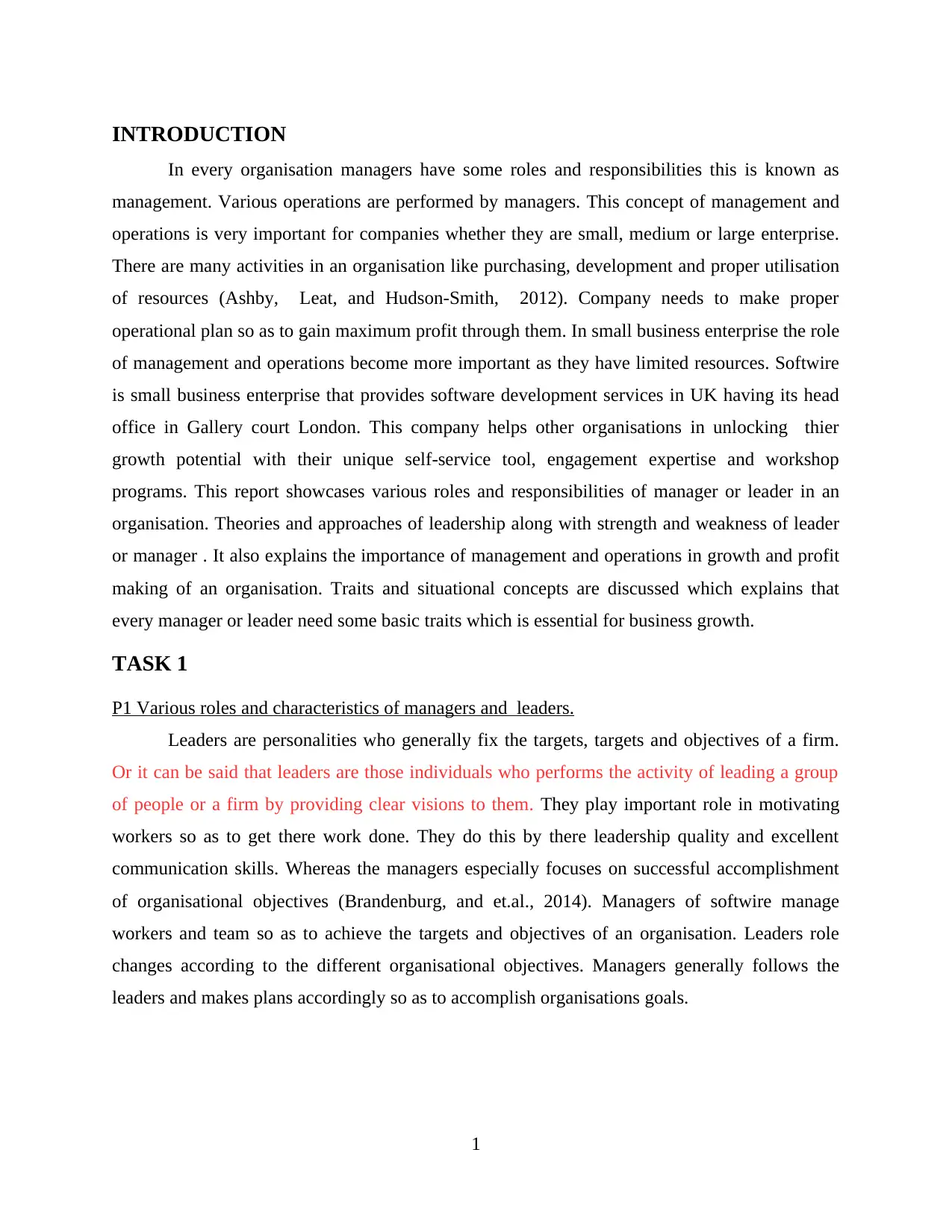
INTRODUCTION
In every organisation managers have some roles and responsibilities this is known as
management. Various operations are performed by managers. This concept of management and
operations is very important for companies whether they are small, medium or large enterprise.
There are many activities in an organisation like purchasing, development and proper utilisation
of resources (Ashby, Leat, and Hudson-Smith, 2012). Company needs to make proper
operational plan so as to gain maximum profit through them. In small business enterprise the role
of management and operations become more important as they have limited resources. Softwire
is small business enterprise that provides software development services in UK having its head
office in Gallery court London. This company helps other organisations in unlocking thier
growth potential with their unique self-service tool, engagement expertise and workshop
programs. This report showcases various roles and responsibilities of manager or leader in an
organisation. Theories and approaches of leadership along with strength and weakness of leader
or manager . It also explains the importance of management and operations in growth and profit
making of an organisation. Traits and situational concepts are discussed which explains that
every manager or leader need some basic traits which is essential for business growth.
TASK 1
P1 Various roles and characteristics of managers and leaders.
Leaders are personalities who generally fix the targets, targets and objectives of a firm.
Or it can be said that leaders are those individuals who performs the activity of leading a group
of people or a firm by providing clear visions to them. They play important role in motivating
workers so as to get there work done. They do this by there leadership quality and excellent
communication skills. Whereas the managers especially focuses on successful accomplishment
of organisational objectives (Brandenburg, and et.al., 2014). Managers of softwire manage
workers and team so as to achieve the targets and objectives of an organisation. Leaders role
changes according to the different organisational objectives. Managers generally follows the
leaders and makes plans accordingly so as to accomplish organisations goals.
1
In every organisation managers have some roles and responsibilities this is known as
management. Various operations are performed by managers. This concept of management and
operations is very important for companies whether they are small, medium or large enterprise.
There are many activities in an organisation like purchasing, development and proper utilisation
of resources (Ashby, Leat, and Hudson-Smith, 2012). Company needs to make proper
operational plan so as to gain maximum profit through them. In small business enterprise the role
of management and operations become more important as they have limited resources. Softwire
is small business enterprise that provides software development services in UK having its head
office in Gallery court London. This company helps other organisations in unlocking thier
growth potential with their unique self-service tool, engagement expertise and workshop
programs. This report showcases various roles and responsibilities of manager or leader in an
organisation. Theories and approaches of leadership along with strength and weakness of leader
or manager . It also explains the importance of management and operations in growth and profit
making of an organisation. Traits and situational concepts are discussed which explains that
every manager or leader need some basic traits which is essential for business growth.
TASK 1
P1 Various roles and characteristics of managers and leaders.
Leaders are personalities who generally fix the targets, targets and objectives of a firm.
Or it can be said that leaders are those individuals who performs the activity of leading a group
of people or a firm by providing clear visions to them. They play important role in motivating
workers so as to get there work done. They do this by there leadership quality and excellent
communication skills. Whereas the managers especially focuses on successful accomplishment
of organisational objectives (Brandenburg, and et.al., 2014). Managers of softwire manage
workers and team so as to achieve the targets and objectives of an organisation. Leaders role
changes according to the different organisational objectives. Managers generally follows the
leaders and makes plans accordingly so as to accomplish organisations goals.
1
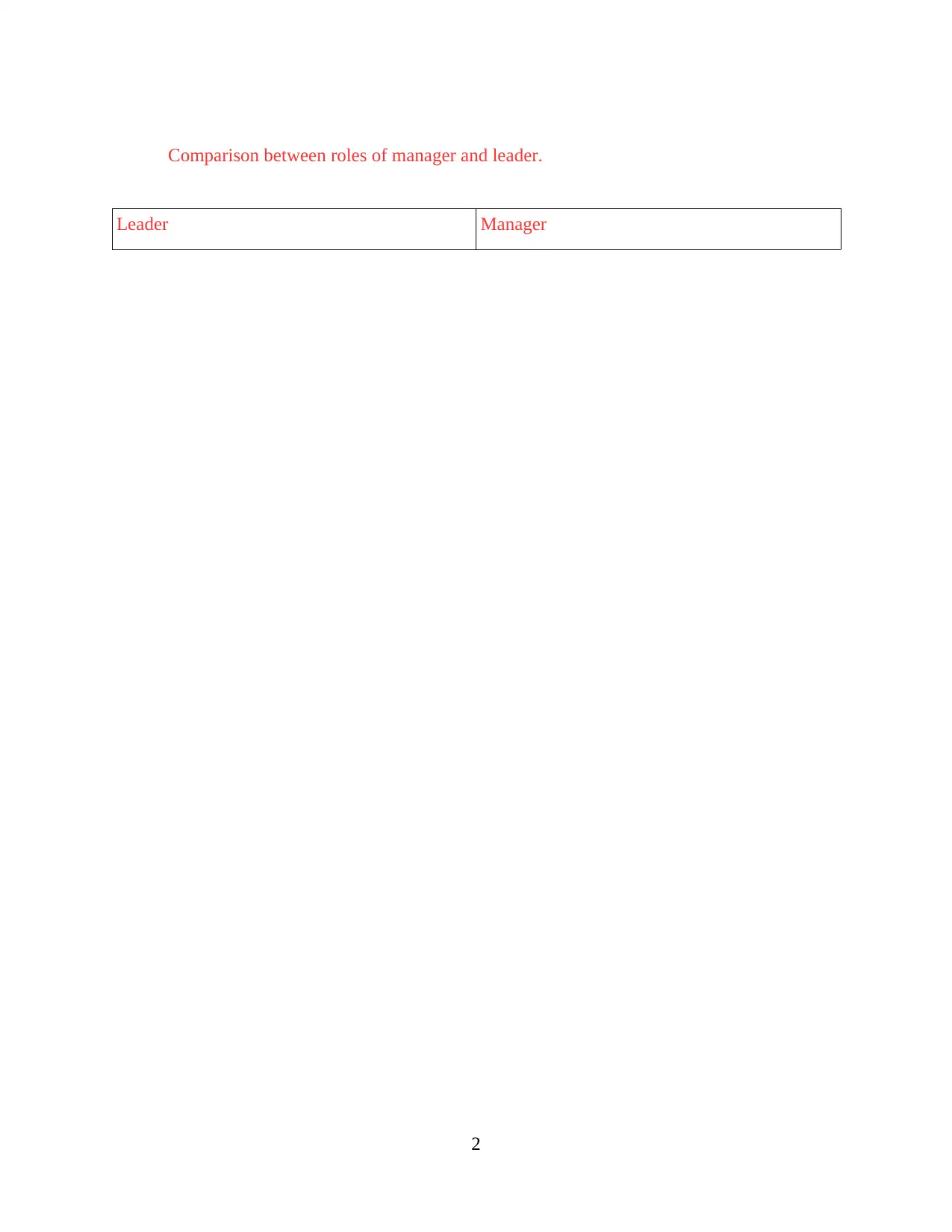
Comparison between roles of manager and leader.
Leader Manager
2
Leader Manager
2
⊘ This is a preview!⊘
Do you want full access?
Subscribe today to unlock all pages.

Trusted by 1+ million students worldwide
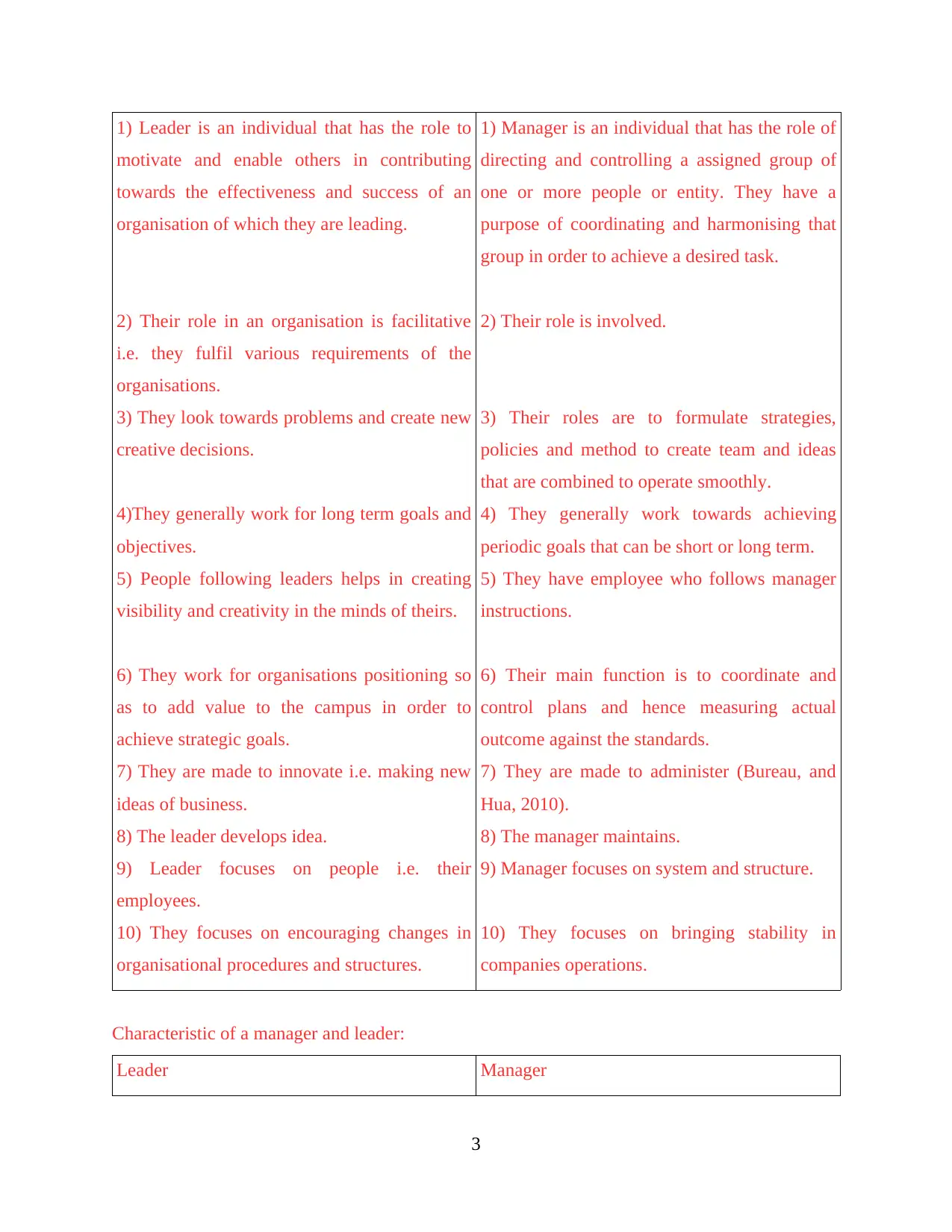
1) Leader is an individual that has the role to
motivate and enable others in contributing
towards the effectiveness and success of an
organisation of which they are leading.
2) Their role in an organisation is facilitative
i.e. they fulfil various requirements of the
organisations.
3) They look towards problems and create new
creative decisions.
4)They generally work for long term goals and
objectives.
5) People following leaders helps in creating
visibility and creativity in the minds of theirs.
6) They work for organisations positioning so
as to add value to the campus in order to
achieve strategic goals.
7) They are made to innovate i.e. making new
ideas of business.
8) The leader develops idea.
9) Leader focuses on people i.e. their
employees.
10) They focuses on encouraging changes in
organisational procedures and structures.
1) Manager is an individual that has the role of
directing and controlling a assigned group of
one or more people or entity. They have a
purpose of coordinating and harmonising that
group in order to achieve a desired task.
2) Their role is involved.
3) Their roles are to formulate strategies,
policies and method to create team and ideas
that are combined to operate smoothly.
4) They generally work towards achieving
periodic goals that can be short or long term.
5) They have employee who follows manager
instructions.
6) Their main function is to coordinate and
control plans and hence measuring actual
outcome against the standards.
7) They are made to administer (Bureau, and
Hua, 2010).
8) The manager maintains.
9) Manager focuses on system and structure.
10) They focuses on bringing stability in
companies operations.
Characteristic of a manager and leader:
Leader Manager
3
motivate and enable others in contributing
towards the effectiveness and success of an
organisation of which they are leading.
2) Their role in an organisation is facilitative
i.e. they fulfil various requirements of the
organisations.
3) They look towards problems and create new
creative decisions.
4)They generally work for long term goals and
objectives.
5) People following leaders helps in creating
visibility and creativity in the minds of theirs.
6) They work for organisations positioning so
as to add value to the campus in order to
achieve strategic goals.
7) They are made to innovate i.e. making new
ideas of business.
8) The leader develops idea.
9) Leader focuses on people i.e. their
employees.
10) They focuses on encouraging changes in
organisational procedures and structures.
1) Manager is an individual that has the role of
directing and controlling a assigned group of
one or more people or entity. They have a
purpose of coordinating and harmonising that
group in order to achieve a desired task.
2) Their role is involved.
3) Their roles are to formulate strategies,
policies and method to create team and ideas
that are combined to operate smoothly.
4) They generally work towards achieving
periodic goals that can be short or long term.
5) They have employee who follows manager
instructions.
6) Their main function is to coordinate and
control plans and hence measuring actual
outcome against the standards.
7) They are made to administer (Bureau, and
Hua, 2010).
8) The manager maintains.
9) Manager focuses on system and structure.
10) They focuses on bringing stability in
companies operations.
Characteristic of a manager and leader:
Leader Manager
3
Paraphrase This Document
Need a fresh take? Get an instant paraphrase of this document with our AI Paraphraser

1) Their personality style are often mercurial
and excellent (Bujak, Carvalho, and Sriramulu,
2012). They have a great charisma. They are
generally loners or private people. They are
decision makers and sometimes takes very
risky decisions. They have high level of
imagination.
2) They are generally people oriented i.e. they
have their own style of leading and work as an
individual.
3) Leaders Display emotions.
4) Their strategy is proactive.
1) They are generally rational, controlled
problem solvers. They focuses on goals,
objectives, structure, personnel and resource
availability. Managers personality converges
towards being persistent, strong will, analysis
and being intelligent.
2) They are generally task oriented people i.e.
their style depends on the task they have to
achieve.
3) Managers display less emotions.
4) Their strategy is reactive.
M1 Roles of leaders & functions of managers by applying ranges of theories & concepts.
Role of leaders is not necessarily to achieve technical and intellectual competencies. But
it is important that leaders and managers follows contrasting attitudes and behaviour according to
various situations that arises.
Various theories that describes the concept of leadership:
Trait theory: Softwire leaders follows this theory which suggests that people are not born
with different attributes but they obtain these qualities for adopting knowledge or skill. It
suggested that leaders who are successful have abilities, interests and personality traits
different from who are less successful.
Situational theory: Cited company faces various situation and develops styles which is
suited for that condition. This theory suggests that most successful leaders were able to
adapt themselves as per the situations and had looked at the cues such as group's nature,
type of task and other factors that contributed for getting things done.
Transactional Theory: This theory suggests that the exchange taken place between the
leader and manager (DeHoratius, and Rabinovich, 2011). They create structure that
focuses to maintain relationship between manager and their subordinates. It includes
directing and motivating followers primarily via appealing to their own self interest as
prime role of followers is to obey the instructions of leader.
4
and excellent (Bujak, Carvalho, and Sriramulu,
2012). They have a great charisma. They are
generally loners or private people. They are
decision makers and sometimes takes very
risky decisions. They have high level of
imagination.
2) They are generally people oriented i.e. they
have their own style of leading and work as an
individual.
3) Leaders Display emotions.
4) Their strategy is proactive.
1) They are generally rational, controlled
problem solvers. They focuses on goals,
objectives, structure, personnel and resource
availability. Managers personality converges
towards being persistent, strong will, analysis
and being intelligent.
2) They are generally task oriented people i.e.
their style depends on the task they have to
achieve.
3) Managers display less emotions.
4) Their strategy is reactive.
M1 Roles of leaders & functions of managers by applying ranges of theories & concepts.
Role of leaders is not necessarily to achieve technical and intellectual competencies. But
it is important that leaders and managers follows contrasting attitudes and behaviour according to
various situations that arises.
Various theories that describes the concept of leadership:
Trait theory: Softwire leaders follows this theory which suggests that people are not born
with different attributes but they obtain these qualities for adopting knowledge or skill. It
suggested that leaders who are successful have abilities, interests and personality traits
different from who are less successful.
Situational theory: Cited company faces various situation and develops styles which is
suited for that condition. This theory suggests that most successful leaders were able to
adapt themselves as per the situations and had looked at the cues such as group's nature,
type of task and other factors that contributed for getting things done.
Transactional Theory: This theory suggests that the exchange taken place between the
leader and manager (DeHoratius, and Rabinovich, 2011). They create structure that
focuses to maintain relationship between manager and their subordinates. It includes
directing and motivating followers primarily via appealing to their own self interest as
prime role of followers is to obey the instructions of leader.
4
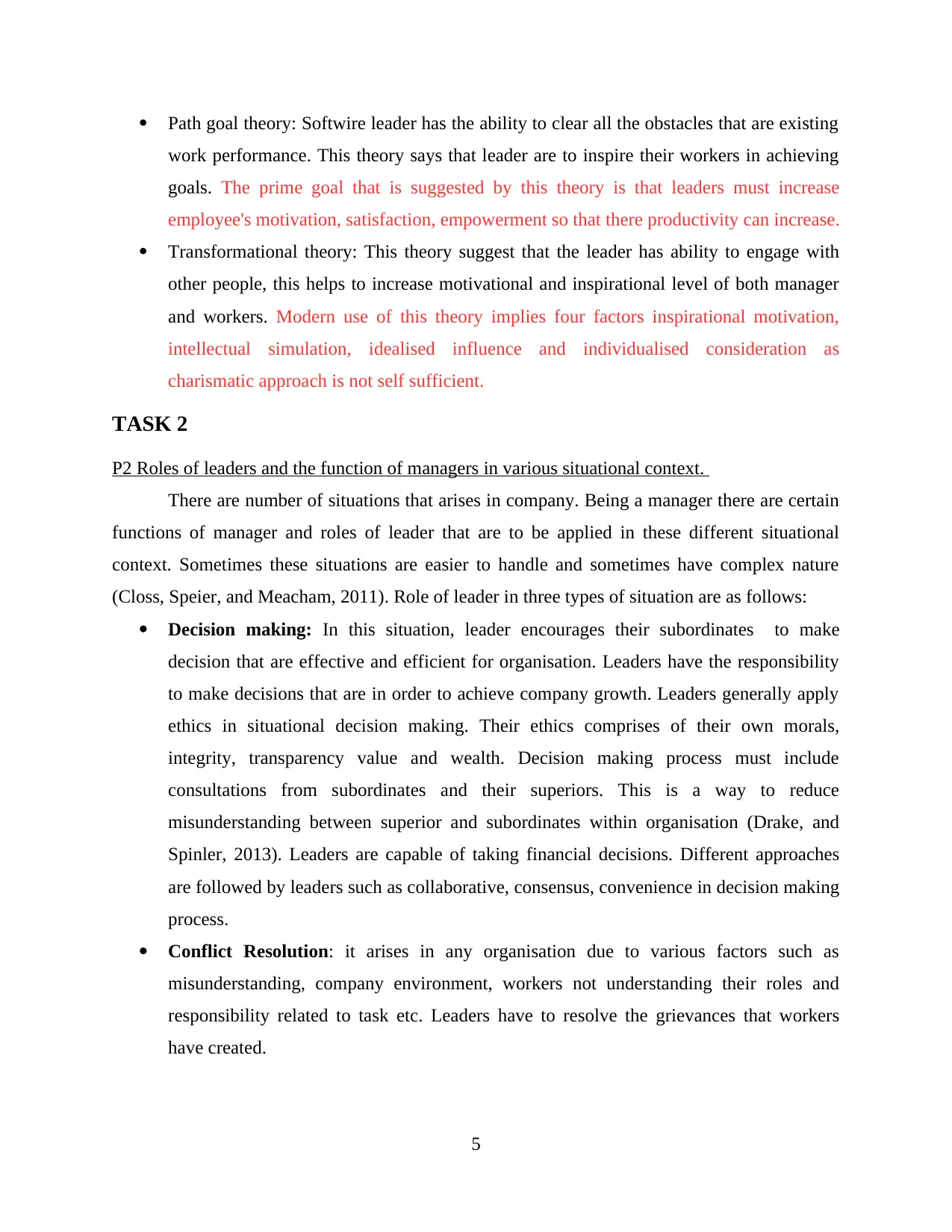
Path goal theory: Softwire leader has the ability to clear all the obstacles that are existing
work performance. This theory says that leader are to inspire their workers in achieving
goals. The prime goal that is suggested by this theory is that leaders must increase
employee's motivation, satisfaction, empowerment so that there productivity can increase.
Transformational theory: This theory suggest that the leader has ability to engage with
other people, this helps to increase motivational and inspirational level of both manager
and workers. Modern use of this theory implies four factors inspirational motivation,
intellectual simulation, idealised influence and individualised consideration as
charismatic approach is not self sufficient.
TASK 2
P2 Roles of leaders and the function of managers in various situational context.
There are number of situations that arises in company. Being a manager there are certain
functions of manager and roles of leader that are to be applied in these different situational
context. Sometimes these situations are easier to handle and sometimes have complex nature
(Closs, Speier, and Meacham, 2011). Role of leader in three types of situation are as follows:
Decision making: In this situation, leader encourages their subordinates to make
decision that are effective and efficient for organisation. Leaders have the responsibility
to make decisions that are in order to achieve company growth. Leaders generally apply
ethics in situational decision making. Their ethics comprises of their own morals,
integrity, transparency value and wealth. Decision making process must include
consultations from subordinates and their superiors. This is a way to reduce
misunderstanding between superior and subordinates within organisation (Drake, and
Spinler, 2013). Leaders are capable of taking financial decisions. Different approaches
are followed by leaders such as collaborative, consensus, convenience in decision making
process.
Conflict Resolution: it arises in any organisation due to various factors such as
misunderstanding, company environment, workers not understanding their roles and
responsibility related to task etc. Leaders have to resolve the grievances that workers
have created.
5
work performance. This theory says that leader are to inspire their workers in achieving
goals. The prime goal that is suggested by this theory is that leaders must increase
employee's motivation, satisfaction, empowerment so that there productivity can increase.
Transformational theory: This theory suggest that the leader has ability to engage with
other people, this helps to increase motivational and inspirational level of both manager
and workers. Modern use of this theory implies four factors inspirational motivation,
intellectual simulation, idealised influence and individualised consideration as
charismatic approach is not self sufficient.
TASK 2
P2 Roles of leaders and the function of managers in various situational context.
There are number of situations that arises in company. Being a manager there are certain
functions of manager and roles of leader that are to be applied in these different situational
context. Sometimes these situations are easier to handle and sometimes have complex nature
(Closs, Speier, and Meacham, 2011). Role of leader in three types of situation are as follows:
Decision making: In this situation, leader encourages their subordinates to make
decision that are effective and efficient for organisation. Leaders have the responsibility
to make decisions that are in order to achieve company growth. Leaders generally apply
ethics in situational decision making. Their ethics comprises of their own morals,
integrity, transparency value and wealth. Decision making process must include
consultations from subordinates and their superiors. This is a way to reduce
misunderstanding between superior and subordinates within organisation (Drake, and
Spinler, 2013). Leaders are capable of taking financial decisions. Different approaches
are followed by leaders such as collaborative, consensus, convenience in decision making
process.
Conflict Resolution: it arises in any organisation due to various factors such as
misunderstanding, company environment, workers not understanding their roles and
responsibility related to task etc. Leaders have to resolve the grievances that workers
have created.
5
⊘ This is a preview!⊘
Do you want full access?
Subscribe today to unlock all pages.

Trusted by 1+ million students worldwide

Risk Taking and avoiding: By analysing the situation sometimes risky decision have to
be taken based on the available resources. There are risk involved in developing a
software for a particular organisation, it is possible that software developed for one of the
clients of softwire may not be helpful for the other clients facing same problem.
Function of a manager:
Planning: It is a function of a manager to plan out a problem that arises in a day to day
situations. For example if softwire has to create a software for data protection than it has
to plan out different possibilities as to how that software will be made.
Organising: Its leader's role to organise its resources so as to execute a given plan. It is
prime responsibility of manager to organise all its resources so as to achieve a given task.
For example in softwire employees are less, managers have to manage employee when
there is need to complete demand of other company to complete the task in given time.
Staffing: It is a function of manager to select the workers according to requirement in
various areas. Manage the number of employee that will be required for that particular
job (Ellison, and Boyd, 2013). For ex. Softwire makes numerous software for that
selection of particular candidates for particular software is necessary.
Leading: Sometimes it is a function of manager to act as leader and lead its subordinates
to accomplish particular task. This leadership is to check proper working and timely
accomplishment of task. For example softwire managers sometimes have to lead a
particular software developing team.
P3 Approach theories & models.
Various models and theories and approaches that are prevalent through the world in any
business firms that defines the role of leader and function of manager. These theories helps use
to determine the type of leader he/she is and how he handles different situations.
Theories of leadership are as follows:
Trait theory: This theory suggests that every individual has some distinct traits or
qualities that help to become a good leader (Metters, and et.al., 2010). Sometimes these
are inborn and sometimes they are taken during a life course through various experiences.
This theory explains the traits of a leader that include mental, social characteristics.
Some leaders are made and some are by birth and this is decided by this theory.
6
be taken based on the available resources. There are risk involved in developing a
software for a particular organisation, it is possible that software developed for one of the
clients of softwire may not be helpful for the other clients facing same problem.
Function of a manager:
Planning: It is a function of a manager to plan out a problem that arises in a day to day
situations. For example if softwire has to create a software for data protection than it has
to plan out different possibilities as to how that software will be made.
Organising: Its leader's role to organise its resources so as to execute a given plan. It is
prime responsibility of manager to organise all its resources so as to achieve a given task.
For example in softwire employees are less, managers have to manage employee when
there is need to complete demand of other company to complete the task in given time.
Staffing: It is a function of manager to select the workers according to requirement in
various areas. Manage the number of employee that will be required for that particular
job (Ellison, and Boyd, 2013). For ex. Softwire makes numerous software for that
selection of particular candidates for particular software is necessary.
Leading: Sometimes it is a function of manager to act as leader and lead its subordinates
to accomplish particular task. This leadership is to check proper working and timely
accomplishment of task. For example softwire managers sometimes have to lead a
particular software developing team.
P3 Approach theories & models.
Various models and theories and approaches that are prevalent through the world in any
business firms that defines the role of leader and function of manager. These theories helps use
to determine the type of leader he/she is and how he handles different situations.
Theories of leadership are as follows:
Trait theory: This theory suggests that every individual has some distinct traits or
qualities that help to become a good leader (Metters, and et.al., 2010). Sometimes these
are inborn and sometimes they are taken during a life course through various experiences.
This theory explains the traits of a leader that include mental, social characteristics.
Some leaders are made and some are by birth and this is decided by this theory.
6
Paraphrase This Document
Need a fresh take? Get an instant paraphrase of this document with our AI Paraphraser

Contingency theory: This theory suggests that there is some kind of contingency existing
in every situation. And managers have to be ready for all these contingent situation.
There is no particular method of handling these contingency situations. It depends on the
leader that how they deal with it. Leaders can change their roles according to given
situation. Softwire uses MC3 concept so as to solve customers problems arising in
different situations.
Transactional theory of leadership: This theory says that every leadership process is an
exchange process. According to it all leaders have increase focus to plans, compensations
and incentive schemes so that workers can do better work as it motivates them. This
theory suggests that some leaders focuses on giving some monetary or verbal rewards in
exchange of their work to be done by there workers. Workers work more when there
needs are satisfied and their motivational levels are high.
Transformational theory of leadership: this theory suggest and explains that leaders focus
to maintain its relationship with customers as well as workers (Montes, and et.al., 2013).
This imbibes trust in the minds of workers and employees. This also helps in increasing
motivational level of an organisational employees.
System theory of leadership: This theory explains that leaders take inputs from outside
world like raw materials, manpower etc. processes it and produces output according to
the needs of customer. It provides framework for presentation and interpretation of
phenomena and realities. It is systematic approach to leadership. This theory provides a
system, a structure, a purpose to resist the alternative chaos (Nagurney, Masoumi, and
Yu, 2012). By using this leadership theory a organisation becomes an open system.
Situational theory of leadership: This theory tells that every leader has rights to change its
approach towards dealing with any situation. They can change their plans and procedures
according to change in business approach and environment. Leaders have to perform
their roles according to the given situation. For example they can change any employee
as per the need of that situation so as to increase the productivity of each worker.
M2 Strength and weakness of different approaches
Every theory prevalent in the world have some strengths as well as weaknesses and it
relies on the condition in which it's being applied.
7
in every situation. And managers have to be ready for all these contingent situation.
There is no particular method of handling these contingency situations. It depends on the
leader that how they deal with it. Leaders can change their roles according to given
situation. Softwire uses MC3 concept so as to solve customers problems arising in
different situations.
Transactional theory of leadership: This theory says that every leadership process is an
exchange process. According to it all leaders have increase focus to plans, compensations
and incentive schemes so that workers can do better work as it motivates them. This
theory suggests that some leaders focuses on giving some monetary or verbal rewards in
exchange of their work to be done by there workers. Workers work more when there
needs are satisfied and their motivational levels are high.
Transformational theory of leadership: this theory suggest and explains that leaders focus
to maintain its relationship with customers as well as workers (Montes, and et.al., 2013).
This imbibes trust in the minds of workers and employees. This also helps in increasing
motivational level of an organisational employees.
System theory of leadership: This theory explains that leaders take inputs from outside
world like raw materials, manpower etc. processes it and produces output according to
the needs of customer. It provides framework for presentation and interpretation of
phenomena and realities. It is systematic approach to leadership. This theory provides a
system, a structure, a purpose to resist the alternative chaos (Nagurney, Masoumi, and
Yu, 2012). By using this leadership theory a organisation becomes an open system.
Situational theory of leadership: This theory tells that every leader has rights to change its
approach towards dealing with any situation. They can change their plans and procedures
according to change in business approach and environment. Leaders have to perform
their roles according to the given situation. For example they can change any employee
as per the need of that situation so as to increase the productivity of each worker.
M2 Strength and weakness of different approaches
Every theory prevalent in the world have some strengths as well as weaknesses and it
relies on the condition in which it's being applied.
7
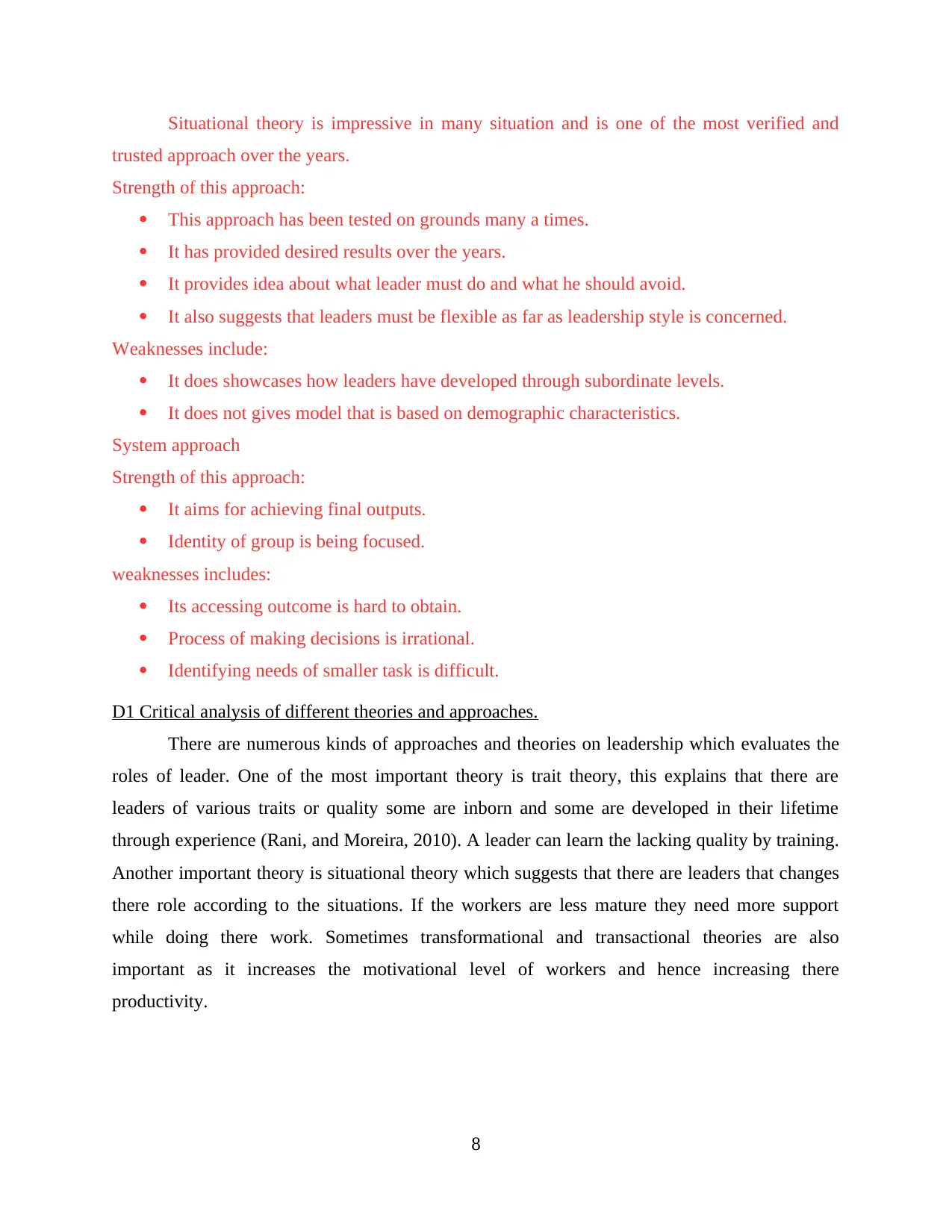
Situational theory is impressive in many situation and is one of the most verified and
trusted approach over the years.
Strength of this approach:
This approach has been tested on grounds many a times.
It has provided desired results over the years.
It provides idea about what leader must do and what he should avoid.
It also suggests that leaders must be flexible as far as leadership style is concerned.
Weaknesses include:
It does showcases how leaders have developed through subordinate levels.
It does not gives model that is based on demographic characteristics.
System approach
Strength of this approach:
It aims for achieving final outputs.
Identity of group is being focused.
weaknesses includes:
Its accessing outcome is hard to obtain.
Process of making decisions is irrational.
Identifying needs of smaller task is difficult.
D1 Critical analysis of different theories and approaches.
There are numerous kinds of approaches and theories on leadership which evaluates the
roles of leader. One of the most important theory is trait theory, this explains that there are
leaders of various traits or quality some are inborn and some are developed in their lifetime
through experience (Rani, and Moreira, 2010). A leader can learn the lacking quality by training.
Another important theory is situational theory which suggests that there are leaders that changes
there role according to the situations. If the workers are less mature they need more support
while doing there work. Sometimes transformational and transactional theories are also
important as it increases the motivational level of workers and hence increasing there
productivity.
8
trusted approach over the years.
Strength of this approach:
This approach has been tested on grounds many a times.
It has provided desired results over the years.
It provides idea about what leader must do and what he should avoid.
It also suggests that leaders must be flexible as far as leadership style is concerned.
Weaknesses include:
It does showcases how leaders have developed through subordinate levels.
It does not gives model that is based on demographic characteristics.
System approach
Strength of this approach:
It aims for achieving final outputs.
Identity of group is being focused.
weaknesses includes:
Its accessing outcome is hard to obtain.
Process of making decisions is irrational.
Identifying needs of smaller task is difficult.
D1 Critical analysis of different theories and approaches.
There are numerous kinds of approaches and theories on leadership which evaluates the
roles of leader. One of the most important theory is trait theory, this explains that there are
leaders of various traits or quality some are inborn and some are developed in their lifetime
through experience (Rani, and Moreira, 2010). A leader can learn the lacking quality by training.
Another important theory is situational theory which suggests that there are leaders that changes
there role according to the situations. If the workers are less mature they need more support
while doing there work. Sometimes transformational and transactional theories are also
important as it increases the motivational level of workers and hence increasing there
productivity.
8
⊘ This is a preview!⊘
Do you want full access?
Subscribe today to unlock all pages.

Trusted by 1+ million students worldwide
1 out of 19
Related Documents
Your All-in-One AI-Powered Toolkit for Academic Success.
+13062052269
info@desklib.com
Available 24*7 on WhatsApp / Email
![[object Object]](/_next/static/media/star-bottom.7253800d.svg)
Unlock your academic potential
Copyright © 2020–2025 A2Z Services. All Rights Reserved. Developed and managed by ZUCOL.





